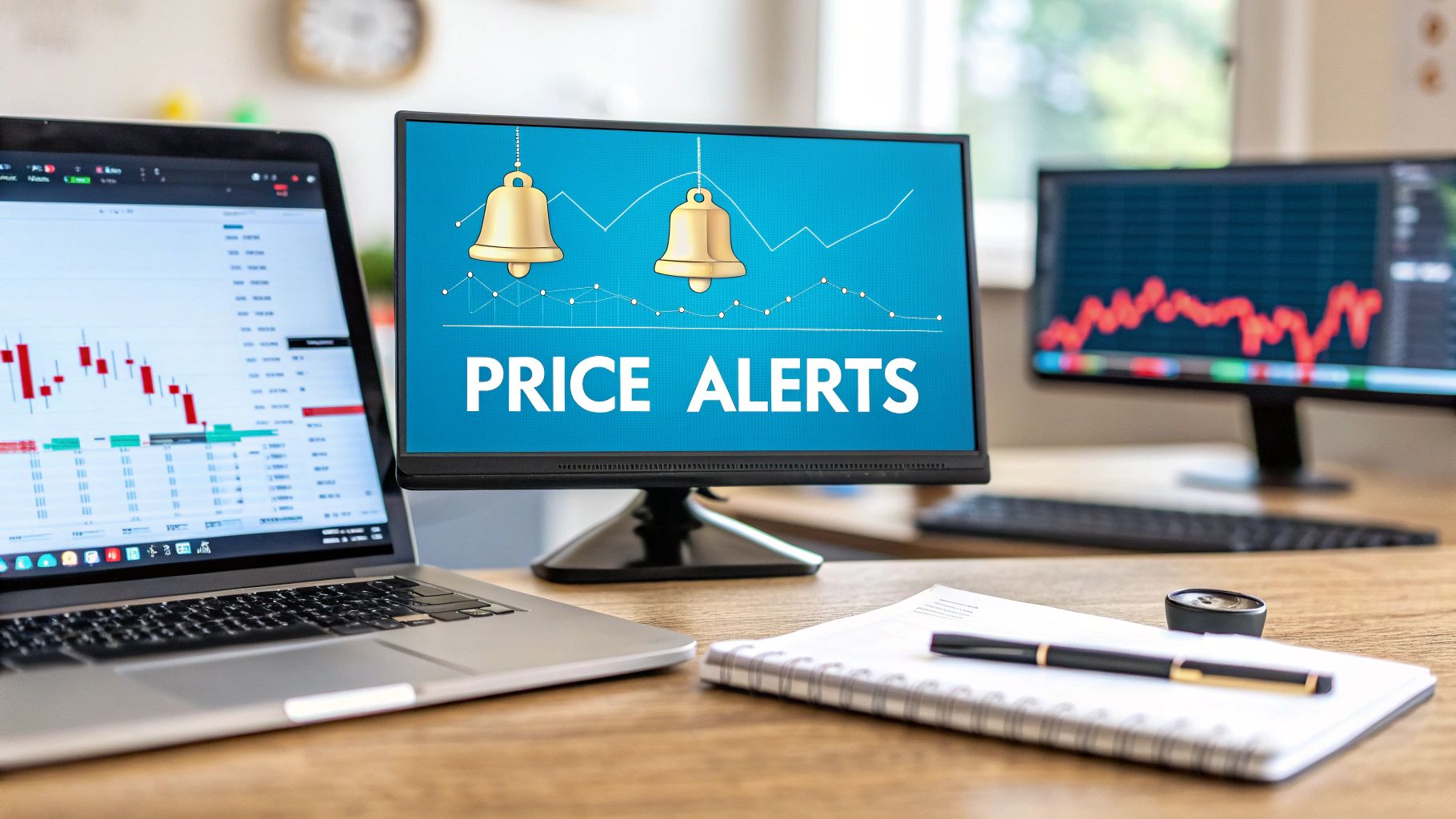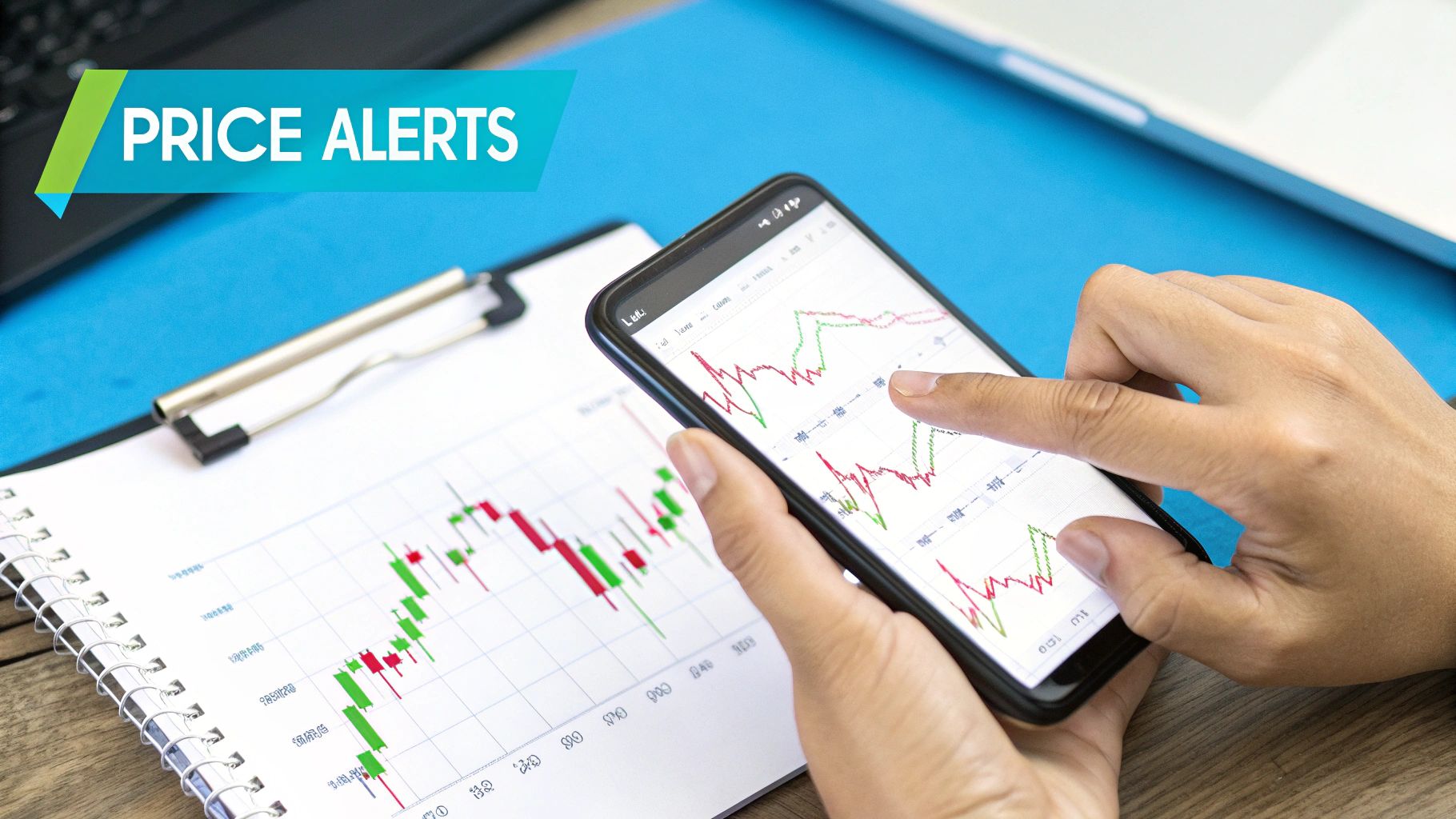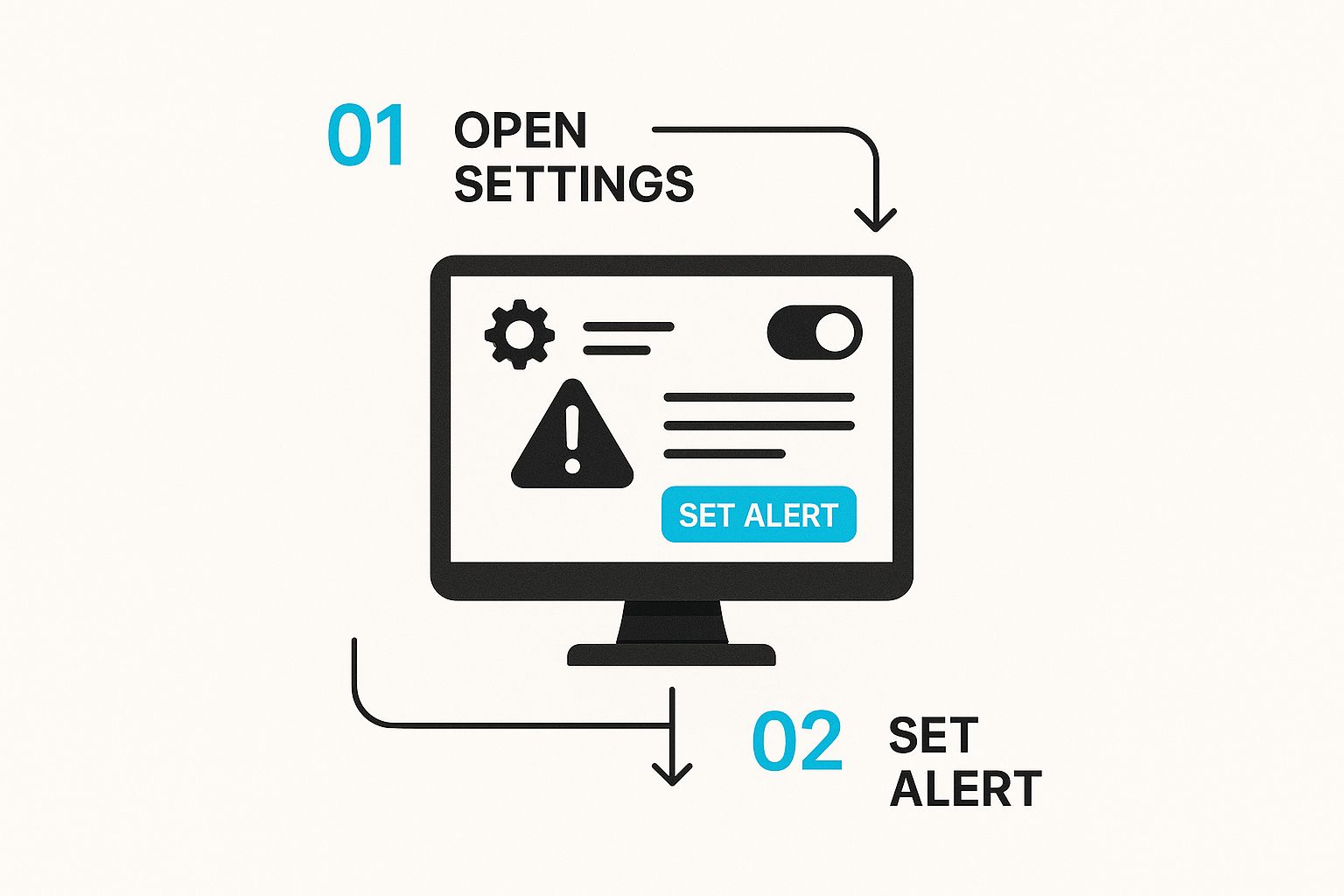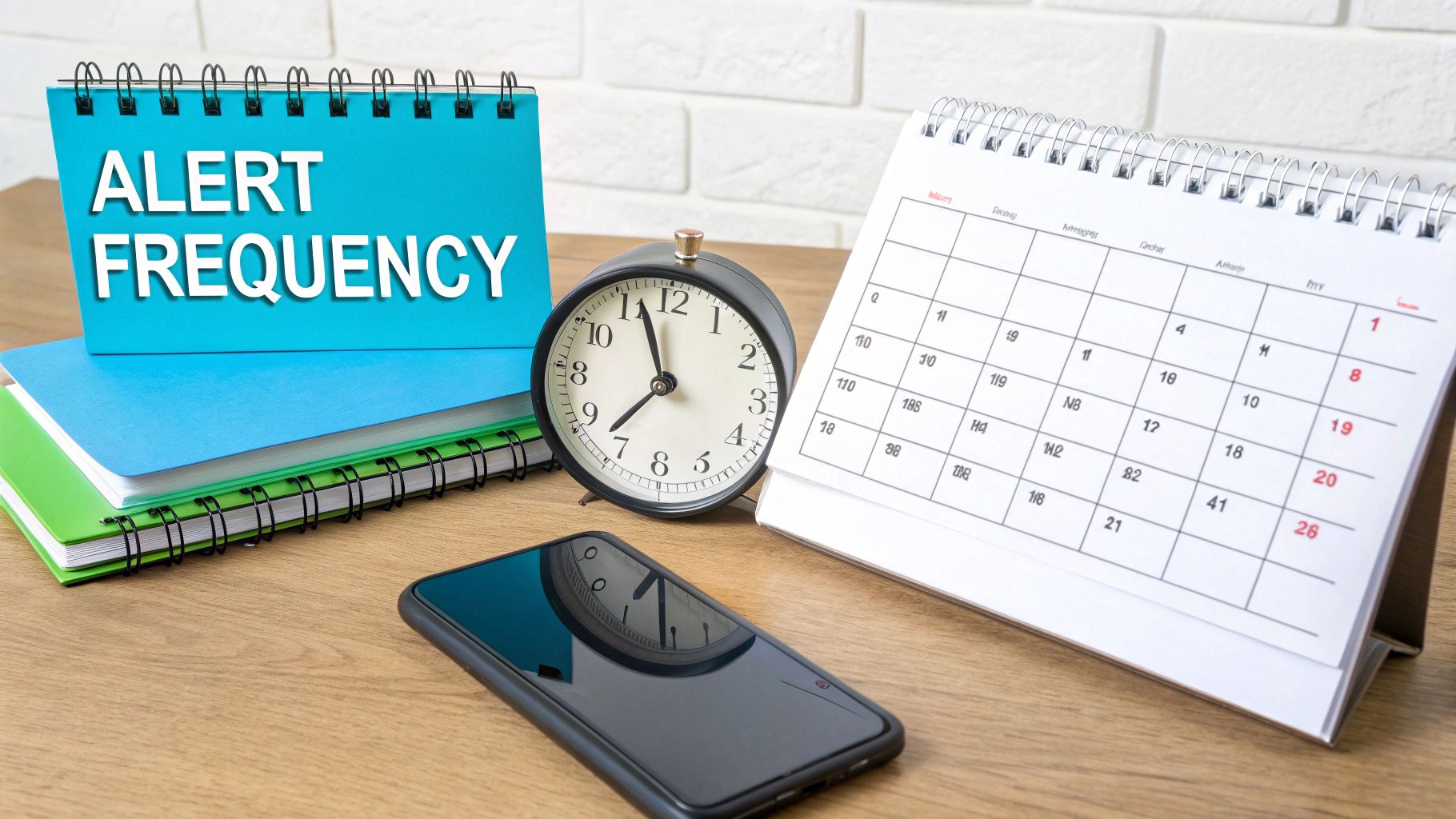




Setting a price alert is pretty straightforward: you pick a specific price for an asset—say, a stock or a crypto coin—and your trading platform will ping you when the market hits that number. It’s a simple trick that lets you react to market moves without having to stare at a screen all day.

A lot of new traders fall into the trap of thinking success means chaining yourself to a desk for eight hours a day, watching every little tick on the chart. That's just a fast track to burnout. The real edge comes from working smarter, and price alerts are your automated eyes on the market, standing guard so you don't have to. They are a cornerstone of any disciplined trading strategy.
Instead of just watching the price bounce around, you get to define what matters. Let's say you're watching Bitcoin and waiting for it to finally break above a major resistance level before you even think about going long. Just set an alert for that price and get on with your life. When that notification hits your phone, then you can pull up the chart, see what's happening, and decide if it's the right time to act.
One of the biggest enemies of any trader is emotion. FOMO (fear of missing out) goads you into jumping into a bad trade, while pure panic can make you sell at the absolute worst time. Price alerts act as a much-needed buffer between a gut reaction and a click of the mouse.
By setting an alert, you’re really just committing to a plan you made with a cool head. When the notification comes through, it’s a signal to execute a pre-planned strategy, not an invitation to make a rash decision based on market noise.
This isn't just about convenience; it's a powerful psychological tool. It helps build discipline by making sure you only engage with the market when your specific conditions are met, not when the market is screaming the loudest.
The widespread adoption of alert systems has exploded thanks to smartphones and better tech, becoming standard practice for anyone tracking price changes. This shift means you can get instant pings for your price points, which saves a massive amount of time and helps you make better decisions. You can dig deeper into AI adoption statistics to see just how big this trend has become.
Price alerts offer a clear view of the market without the constant screen time. Let's look at the main advantages.
In the end, it’s about having a system that works for you.
Ultimately, using price alerts gives you your freedom back. You can step away, live your life, and trust that you won’t miss the very opportunities you've been patiently waiting for.
Alright, let's get your first price alert set up in TradingView. It’s easy to create an alert, but the real trick is making it smart—one that actually helps you execute a specific trading plan instead of just pinging you when a price changes.
We’ll walk through a classic scenario: a breakout above a key resistance level.
Imagine you're eyeing a stock that just can't seem to break past $150. It’s bounced off that price a few times, but your strategy is to go long if it finally punches through with some conviction. Staring at the chart all day is out of the question. This is where a well-placed alert becomes your personal market watcher.
Here's a look at the kind of interface you'll be using to build these alerts.

It might look like a lot of options at first, but once you know what to focus on, it's incredibly simple.
First, open your chart in TradingView and look for the "Alert" icon on the right-hand toolbar—it looks like a little alarm clock. Click it, and the alert creation menu will pop right up. This is where you tell TradingView exactly what you're waiting for.
For our $150 breakout scenario, here’s how to set it up for maximum effectiveness:
Once the logic is set, you get to decide how you want to be notified. TradingView can send you an email, a pop-up on the platform, or even use a webhook if you’re into automation.
Do yourself a favor and give it a descriptive name. Something like "AAPL $150 Breakout Confirmation" is perfect. When that alert fires a week from now, you’ll know exactly what it means and what your plan was.
Key Takeaway: The goal isn't just to be notified of a price. It's to create a trigger for a specific, pre-planned action. This simple setup turns a basic alert into a powerful tool for disciplined trading.

Basic price alerts are useful, no doubt. But what if your alerts could be smarter? What if they could think more like an experienced trader? That's exactly where EzAlgo comes in, turning a simple notification into an active part of your trading strategy.
Instead of just pinging you when a certain price level is hit, EzAlgo's alerts can trigger based on the proprietary signals generated by our indicators. This is a game-changer. You're no longer limited to static price points; you can build alerts around specific market behaviors and algorithmic confirmations, letting the indicators do the heavy lifting for you.
Let’s walk through a real-world example. Imagine you're a swing trader and the Ez-Crossover signal is your go-to for entry confirmations. The old way would be to set a price alert near a potential crossover point and then stare at the chart, waiting. The new way? Create an alert that fires the exact moment a buy or sell crossover prints on your chart.
Here’s how you’d set that up in the TradingView alert menu:
Just like that, you have an automated assistant monitoring your exact entry signal across any market, on any timeframe. This works beautifully for scalpers too, who might want instant notifications for things like momentum shifts or bullish divergence signals on a 1-minute chart.
By tying your alerts directly to algorithmic signals, you are effectively automating your chart analysis. You no longer have to hunt for setups; the setups come to you.
This hands-off approach is incredibly valuable. It frees up your time and mental energy, but more importantly, it helps enforce discipline. You're forced to wait for a confirmed signal before you even think about placing a trade, which keeps you aligned with your plan.
The real magic here is how adaptable this is. You can craft incredibly specific alerts for just about any market condition or trading style. This is a huge step toward building a more automated workflow, and you can even take it further. Our guide on TradingView automated trading shows how these alerts can link directly to execution platforms.
Think about the possibilities. You could set up alerts for:
Each of these custom alerts acts as a powerful filter. They cut through all the market noise and deliver only the most relevant, actionable information right to your screen. This is how you level up from just reacting to price movements to proactively executing a refined, signal-based strategy.
Once you've got the basics down, it's time to start refining your alerts into a truly high-precision tool. Small tweaks can make a massive difference, helping you filter out market noise and avoid the false alarms that lead to bad trades. This is how you go from getting simple pings to conducting strategic market monitoring.
A classic mistake is relying on a generic "Greater Than" condition. Get more specific. Using "Crossing Up" or "Crossing Down" triggers the alert only the first time your price target is hit. This is a game-changer for preventing a flood of notifications if the price just bounces around a key level.
Another great technique is to build "zones of interest" by setting up a few alerts around the same area. For instance, set one alert when a stock enters a support zone and a second one if it breaks below it. This approach gives you a much clearer picture of what's happening at critical price points, so you can plan for either a bounce or a breakdown.
Let's be real: not all alerts are created equal. A signal for your main trade setup is way more important than a heads-up on a minor level. Most platforms, including TradingView, let you customize the notification itself, and you should absolutely take advantage of that.
This kind of personal touch is especially vital for effective swing trading alerts, where getting clear information at the right time is everything.
The goal is to make your alerts so clear and intentional that you know exactly what to do the moment one triggers. An effective alert isn't just data; it's a direct call to a pre-planned action.
Remember, these systems are designed to grab your attention. Push notifications are a huge part of this, with Europe showing an average reaction rate of 8.85%. Interestingly, this rate shifts depending on the device—Android users react 11.5% of the time, while iOS users are at 5.5%. It's a good reminder that how we receive information matters. You can dig into more push notification engagement statistics to see the bigger picture.
Finally, do yourself a favor and set expiration dates on your alerts. If a setup is only relevant for the current trading week, make sure the alert expires on Friday. This keeps your charts clean and prevents an old, forgotten alert from triggering on outdated analysis down the road.
Price alerts are a fantastic tool, but they can quickly turn into a nightmare of constant pings and notifications if you're not careful. The biggest mistake I see traders make is setting way too many alerts without a real plan. This leads to alert fatigue, where you get so many notifications for tiny price moves that you start tuning them all out. Then, when a truly important alert comes through, you miss it.
Another classic blunder is setting alerts that trigger on price wicks instead of waiting for a candle to close. A stock might poke above a resistance level for a split second, setting off your alert, only to get slammed back down. This creates a ton of false signals and can easily trick you into jumping the gun on a trade. Whenever you can, use the "once per bar close" option to make sure the price has actually held its ground.
Think of your alert system like a garden—it needs regular tending to stay useful. If you just let them pile up, you'll end up with a mess of weeds.
Here’s how to stay on top of it:
A good alert should be a clear call to action. It should mean something specific to your trading plan. If you get a notification and don't know exactly what you're supposed to do next, that alert is just noise.
The technology powering these systems is exploding. The market for mass notification systems is expected to jump from USD 16.48 billion in 2024 to a staggering USD 69.30 billion by 2032. You can read more about the booming growth of notification tech, which just goes to show how crucial it is to manage this constant stream of information.
Even with the best plan, you're bound to have a few questions when you start putting price alerts into practice. Let's walk through some of the things traders often ask.
This is a great question, and there’s no single right answer. The real goal is to get alerts that matter, not just create a bunch of noise that you end up ignoring.
For a day trader watching a few specific stocks, setting 5-10 high-quality alerts for each one is pretty common. These might be for key support/resistance breaks or indicator crossovers. If you're a long-term investor, you might only need one or two alerts for major price levels you’ve been waiting for.
My best advice? Tidy up your alerts every week. If an alert is no longer relevant to your current strategy, just delete it. This keeps you focused and prevents "alert fatigue."
For the most part, yes. A quality platform like TradingView delivers alerts almost instantly. But you have to remember that things like your own internet connection or even your phone's settings can cause tiny delays.
If you’re a scalper where every second counts, you should never put 100% faith in a single alert. It's a fantastic tool, but it's not foolproof. A quick tip: check your phone’s settings to make sure it isn’t putting your trading app to sleep to save battery. That's a common culprit for missed notifications.
Think of your alert system as your primary heads-up, but always have a way to quickly double-check the chart for your most critical entries and exits.
Absolutely. The same principle works for almost anything with a fluctuating price.
You can set alerts for:
Once you get the hang of it, you'll find all sorts of ways to use alerts to your advantage.
Ready to set alerts based on powerful algorithmic signals, not just simple price levels? EzAlgo works right inside TradingView, giving your alerts a serious upgrade. Explore EzAlgo's advanced indicators today.